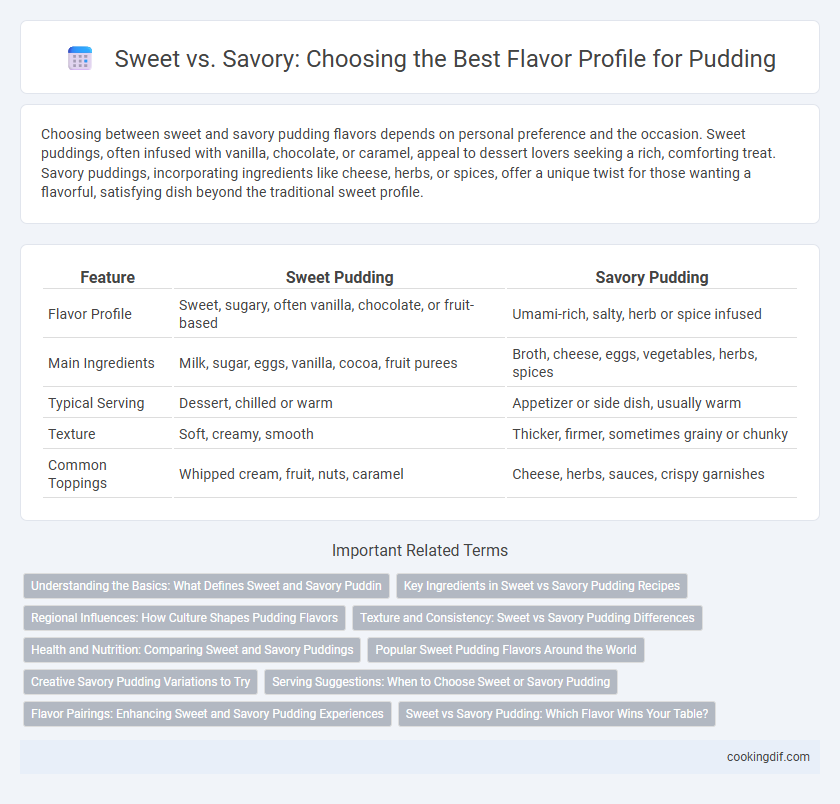Choosing between sweet and savory pudding flavors depends on personal preference and the occasion. Sweet puddings, often infused with vanilla, chocolate, or caramel, appeal to dessert lovers seeking a rich, comforting treat. Savory puddings, incorporating ingredients like cheese, herbs, or spices, offer a unique twist for those wanting a flavorful, satisfying dish beyond the traditional sweet profile.
Table of Comparison
| Feature | Sweet Pudding | Savory Pudding |
|---|---|---|
| Flavor Profile | Sweet, sugary, often vanilla, chocolate, or fruit-based | Umami-rich, salty, herb or spice infused |
| Main Ingredients | Milk, sugar, eggs, vanilla, cocoa, fruit purees | Broth, cheese, eggs, vegetables, herbs, spices |
| Typical Serving | Dessert, chilled or warm | Appetizer or side dish, usually warm |
| Texture | Soft, creamy, smooth | Thicker, firmer, sometimes grainy or chunky |
| Common Toppings | Whipped cream, fruit, nuts, caramel | Cheese, herbs, sauces, crispy garnishes |
Understanding the Basics: What Defines Sweet and Savory Puddin
Sweet pudding typically features sugar, vanilla, and fruits as dominant flavors, creating a rich and creamy dessert profile. Savory pudding incorporates ingredients like herbs, cheese, and spices to provide a more complex, umami taste often served as a side or appetizer. Understanding these flavor bases helps differentiate pudding varieties by their core ingredient combinations and intended culinary role.
Key Ingredients in Sweet vs Savory Pudding Recipes
Sweet pudding recipes typically feature key ingredients like sugar, vanilla, cocoa, and fruit purees to enhance natural sweetness and create rich, creamy textures. Savory puddings often incorporate ingredients such as cheese, herbs, spices, and eggs to deliver a hearty, umami flavor profile that complements vegetables or meats. The choice of base--milk or cream for sweet, broth or stock for savory--also significantly influences the pudding's final taste and consistency.
Regional Influences: How Culture Shapes Pudding Flavors
Pudding flavors vary significantly across regions, reflecting deep cultural influences that shape sweet and savory profiles. In Western countries, sweet puddings often feature ingredients like vanilla, chocolate, and fruits, while Asian cultures emphasize savory versions using ingredients such as soy sauce, mushrooms, and seafood. This cultural diversity highlights how regional tastes and local ingredients impact the traditional preparation and flavor development of pudding.
Texture and Consistency: Sweet vs Savory Pudding Differences
Sweet pudding typically features a smooth, creamy texture with a thick, velvety consistency achieved through sugar and dairy ingredients like milk or cream. Savory pudding often has a denser, more robust texture, incorporating ingredients such as starches, eggs, or vegetables to create a firm yet tender consistency. The contrast in texture and consistency between sweet and savory pudding greatly influences their respective mouthfeel and culinary applications.
Health and Nutrition: Comparing Sweet and Savory Puddings
Sweet pudding often contains higher sugar content, contributing to increased calorie intake and potential blood sugar spikes, while savory pudding typically incorporates ingredients like vegetables, herbs, and proteins, offering a more balanced nutritional profile with lower glycemic impact. Sweet variants may provide quick energy but can lead to insulin resistance if consumed excessively, whereas savory puddings support sustained energy release and a richer supply of vitamins and minerals. Choosing between sweet and savory pudding depends largely on individual dietary goals, with savory options generally favoring health-conscious consumers seeking nutrient density and reduced sugar.
Popular Sweet Pudding Flavors Around the World
Popular sweet pudding flavors vary globally, with vanilla, chocolate, and rice pudding dominating Western tastes, while mango and coconut flavors are favored in tropical regions such as Southeast Asia. In the United Kingdom, sticky toffee pudding is a beloved dessert, whereas in India, kheer made from cardamom and saffron-infused milk is widely enjoyed. These sweet variations highlight diverse cultural preferences and showcase the versatility of pudding as a dessert.
Creative Savory Pudding Variations to Try
Savory pudding variations elevate traditional dessert flavors by incorporating ingredients like roasted garlic, caramelized onions, and aged cheeses, offering a rich umami profile. Experiment with herb-infused puddings such as rosemary and Parmesan or spiced lentil puddings blended with cumin and coriander for a nutritious twist. These creative savory puddings provide unique texture contrasts and bold flavors that satisfy both adventurous eaters and those seeking comfort foods.
Serving Suggestions: When to Choose Sweet or Savory Pudding
Sweet pudding is ideal for dessert occasions, pairing well with fresh fruits, whipped cream, or a drizzle of caramel for a satisfying end to a meal. Savory pudding suits lunch or dinner, often served alongside roasted meats, vegetables, or topped with herbs and cheese for a hearty, flavorful dish. Choosing sweet or savory pudding depends on the meal context and desired flavor profile to complement other courses effectively.
Flavor Pairings: Enhancing Sweet and Savory Pudding Experiences
Sweet pudding flavors pair excellently with fruits like berries, caramel, and vanilla, enhancing their creamy texture and providing a balanced sweetness. Savory puddings benefit from savory herbs, spices such as thyme or black pepper, and ingredients like cheese or mushrooms, amplifying umami and depth of flavor. Combining contrasting elements like salty toppings on sweet puddings or sweet glazes on savory puddings creates intriguing flavor profiles that elevate the overall sensory experience.
Sweet vs Savory Pudding: Which Flavor Wins Your Table?
Sweet pudding flavors, such as vanilla, chocolate, and caramel, dominate dessert menus with their rich, creamy textures and satisfying sweetness that appeal to a broad audience. Savory puddings, featuring ingredients like cheese, herbs, and spices, offer a unique twist that complements main courses and provides a balanced, flavorful alternative. Choosing between sweet and savory pudding depends on the meal context and personal preference, with sweet puddings excelling as traditional desserts and savory versions gaining popularity in contemporary cuisine.
Sweet vs Savory for pudding flavor Infographic

 cookingdif.com
cookingdif.com